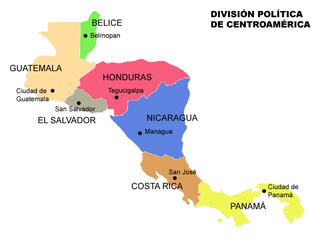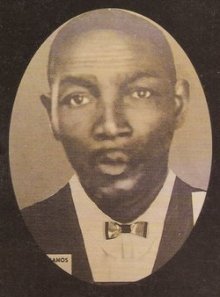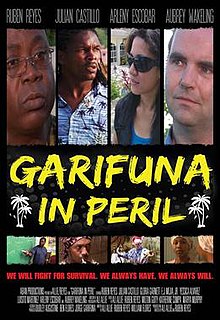This article is an orphan, as no other articles link to it . Please introduce links to this page from related articles ; try the Find link tool for suggestions. (April 2016) |
The National Garifuna Council NGC (Belize) is a non-governmental organization that represents the Indigenous Garifuna people of Belize. [1] Their mission is to preserve, strengthen and develop the Garifuna culture, as well as to promote economic development, interracial harmony of the Garifuna people, and maintain traditional respect for preserving the environment . It was established in 1981 and is managed by a board of directors with corresponding branches in Guatemala, Honduras and Nicaragua. These countries all share the unique Garifuna culture, as the all served as refuge to the Garifuna people when they were exiled from their homeland St. Vincent.
The Garinagu arrived in Belize in 1802 in small amount and in 1832 in larger amount. As a result of the free status of the Garinagu in a settlement whose black population was still enslaved, conflict arose between them and the white land owners. They disallowed contact between the slaves and the Garinagu, and tried tirelessly to keep the Garinagu from advancing within the community. [2] Despite such efforts of the colonial masters, in 1922, the Carib Development Society was formed through the efforts of Thomas Vincent Ramos in Dangriga Town. Its purpose was to help the sick and offer financial support to those in need of it. After his death, the work was taken up by a group of people known as the National Garifuna Council (NGC) along with the Cairb Development Society (CDS). However, it was until 1981, that NGC outlined its objectives in a Memorandum.
Some objective of the National Garifuna Council includes; fostering economic development in Garifuna communities, by facilitating business growth, ensuring that the Garifuna cultural heritage is nurtured and promoted, to advocate for education and community outreach programs that seeks to address the issues that affect the people and to empower youth participation in the development of the culture, among others. [3]
Any individual who reaches the age of 15 can become a member after subscribing and paying an entrance fee. NGC is managed by a board of directors consisting of 15 and not more than 30 members, who are responsible to register and keep records of such members. The headquarters NGC is situated in Dangriga Town, in the Stann Creek District, in the country of Belize. Memorandum of Association (Constitution) of National Garifuna Council. An annual convention is held once every year at a place prescribed at the convention or by the directors. Twenty five members make up quorum for a convention, but half of the existing branches must be represented, if not it must be dissolved. The president of the board of directors and in his absence the Vice President chairs all convention. In the absence of both the President and the Vice President, a member selected by the convention shall be the chairman of the convention. Business at the convention includes; receiving and adopting the report of the Directors, the financial reports, amendments to the constitution of the council. [4]
On April 12, 1997, the anniversary of the arrival of the Garifuna people in Central America was celebrated. This event brought about awareness to the circumstances surrounding their exile from their homeland St. Vincent such as; the real reason for the attempted genocide and their appreciation for survival. The mere fact that they survived such inhumane treatment and managed to exist today brought them to the realization that their culture is threatened. [5]
The National Garifuna Council prepared a draft Language Policy Statement of the Garifuna Nation for the Central American Black Organization (CABO) meeting that was to be held in December 1997. The draft outlined the reason for and the request for a language policy and development initiatives, as well as for the rights of the indigenous people to be guaranteed by the local governments of Belize, Guatemala, Honduras and Nicaragua, and declared by the United Nations. Another accomplishment was the building of the Pablo Lambey Garifuna Cultural Center in Dangriga. In the year 1999, NGC signed a memorandum of understanding between themselves and the Government of Belize.
The United Nations Educational, Scientific and Cultural Organization (UNESCO) developed an action plan that seeks to secure recognition of the Garifuna language and culture by the government of Belize, Guatemala, Honduras, and Nicaragua. It seeks to address the concerns of the culture a series of activities relating to land, education, language, culture, other social issues and community and economic development. [6] UNESCO acknowledged that during this era of globalization, many areas of the Garifuna culture were disappearing, threatened by cultural standardization, conflict, armed conflict, industrialization, migration, and environmental deterioration. Thus, in 2001, UNESCO declared the Garifuna Language, Dance and Music of Belize, “Masterpiece of the Oral and Intangible Heritage of Humanity.” This initiative helps The Garifuna to gain international recognition in cultural identity and promote harmonious interaction between cultures.
NGC has completed a 2-year institutional strengthening project, which focused on providing technical support to build the capacity of the organization in order to fulfill its mandate. The objective was to develop the income generating potential of Garifuna communities and NGc while considering the culture for business opportunities, and to improve the socio-economic situation of most Garifuna communities. NGC also developed the Hamali Garinagu NGC Radio Station in Dangriga Town in the year 2002. In 2004, they opened the First Garifuna Museum in Belize located at the Monument Land. This museum was mainly finance by a grant from the Taiwan Government, assisted by the Government of Belize as well as private donors.
On September 11, 2007, the National Garifuna Council with the support of the Ministry of Education opened a new pre and primary school, named Gulisi Primary School. This school was named in honor of Gulisi, the daughter of the legendary Chief Joseph Chatoyer. At the school the students are taught equally in the native Garifuna language and English while carrying out the standard primary school curriculum of Belize.
References

Belize, formerly known as British Honduras, is a Caribbean country located on the northeastern coast of Central America. Belize is bordered on the northwest by Mexico, on the east by the Caribbean Sea, and on the south and west by Guatemala. It has an area of 22,970 square kilometres (8,867 sq mi) and a population of 408,487 (2019). Its mainland is about 290 km (180 mi) long and 110 km (68 mi) wide. It has the lowest population and population density in Central America. The country's population growth rate of 1.87% per year is the second highest in the region and one of the highest in the Western Hemisphere.

Dangriga, formerly known as Stann Creek Town, is a town in southern Belize, located on the Caribbean coast at the mouth of the North Stann Creek River. It is the capital of Belize's Stann Creek District. Dangriga is served by the Dangriga Airport. Commonly known as the "culture capital of Belize" due to its influence on punta music and other forms of Garifuna culture, Dangriga is the largest settlement in southern Belize.

The Garifuna people are a mixed African and indigenous people originally from the Caribbean island of Saint Vincent who speak Garifuna, an Arawakan language.

Punta rock or Belizean punta is a form of the traditional punta rhythm of the Garifuna people of Belize, Guatemala, Honduras. Although most artists and bands are exclusively Garifuna, songs are usually in Kriol or Garifuna and rarely in Spanish, or English.
Punta is an Afro Indigenous dance and music originated by the Garifuna people with African and Arawak elements.

Andy Vivian Palacio was a Belizean Punta musician and government official. He was also a leading activist for the Garifuna people and their culture.
Garifuna (Karif) is a minority language widely spoken in villages of Garifuna people in the western part of the northern coast of Central America.

Central America is a subregion of the Americas formed by six Latin American countries and one (officially) Anglo-American country, Belize. As an isthmus it connects South America with the remainder of mainland North America, and comprises the following countries : Belize, Guatemala, Honduras, El Salvador, Nicaragua, Costa Rica, and Panama.
Theodore "Ted" Aranda, Ph.D. is a Belizean politician and Garifuna activist.
Belize, on the east coast of Central America, southeast of Mexico, was inhabited by the indigenous peoples who fought off the Spaniards in an attempt to preserve their heritage and to avoid the fate of their neighbors who were conquered and under Spanish rule. While this was going on, British pirates would rob Spanish merchant ships and navigate through the shallow waters and small islands even going up river later to hide their bounty. The indigenous people of Belize did not resist the British like they did the Spanish. In the 17th century, however, the British settlement became a formal British crown colony from 1862 through 1964, where they first achieved self government and later in 1981 became an independent country recognized globally with all its territory intact. The British brought along with them slaves taken from Congo and Angola during the eighteenth century.
The History of Belize dates back thousands of years. The Maya civilization spread into the area of Belize between 1500 BC to 1200 BC and flourished until about 1000 AD. Several Maya ruin sites, including Cahal Pech, Caracol, Lamanai, Lubaantun, Altun Ha, and Xunantunich reflect the advanced civilization and much denser population of that period. The first recorded European incursions in the region were made by Spanish conquistadors and missionaries in the 16th century, who nevertheless failed to establish colonial rule. English loggers and pirates sporadically visited the region in the 17th century, and the first English settlements were established around 1716. The 18th century in Belize was marked by frequent conflict between Britain and Spain and the arrival of enslaved Africans to British plantations.

Belizeans are people associated with the country of Belize through citizenship or descent. Belize is a multiethnic country with residents of African, Amerindian, European and Asian descent or any combination of those groups.

This is an Index of Central America-related articles. This index defines Central America as the seven nations of Belize, Costa Rica, El Salvador, Guatemala, Honduras, Nicaragua, and Panama.

Thomas Vincent Ramos, commonly known as T. V. Ramos, was a Belizean civil rights activist who promoted the interests of the Garifuna people, and is now considered a national hero.
Afro-Hondurans or Black Hondurans, are Hondurans of African descent. They descended from Africans, who were enslaved from the West Indies and identified as Garifunas and Creole peoples. The Creole people were originally from Jamaica and other Caribbean islands, while the Garifuna people were originally from Saint Vincent and the Grenadines. Garifunas arrived in the late seventeen hundreds and the Creole peoples arrived during the eighteen hundreds.

Garifuna Americans or Black Carib Americans are Americans of African and Indigenous descent with origins from Honduras, Guatemala, Belize and Nicaragua and trace their ancestry to Saint Vincent And The Grenadines. As of 2012, Abrazo Garifuna in New York, an event celebrating the contributions of Garifuna Americans to New York City is in its second year. Abrazo Garifuna in New York continues to be held annually as of 2014.

Garifuna in Peril is a low-budget independent fiction docufiction feature film directed, written, and produced by Alí Allié and Rubén Reyes. The film depicts historical and contemporary issues within the Garinagu Afro-Honduran indigenous community and features a cast of actors from Honduras and Belize.
Teofilo Colon Jr. is a Garifuna-American photographer, filmmaker, writer and journalist. Colon has created an online archive of information about the Garifuna culture, an Afro-Caribbean population made up of formerly African, Island Caribs, Arawak people exiled by the British from Saint Vincent Island to Roatán, an island off the coast of Honduras, who eventually emigrated to the Caribbean coasts of the Central American countries of Honduras, Belize, Guatemala, Nicaragua - with its biggest concentration outside that area in New York City, found most intensively in the Bronx.
Mirtha Colón is a Honduran-born Garifuna activist and social worker who assists Caribbean migrants in The Bronx and travels widely supporting the issues of HIV prevention, sex education and cultural preservation. In 2012, she was recognized by the New York State Legislature for her service to the African diaspora in the state.
Iris Myrtle Palaciao is an educator and social planner from Belize. She is an advocate for Garifuna culture, and good governance in the public sector.